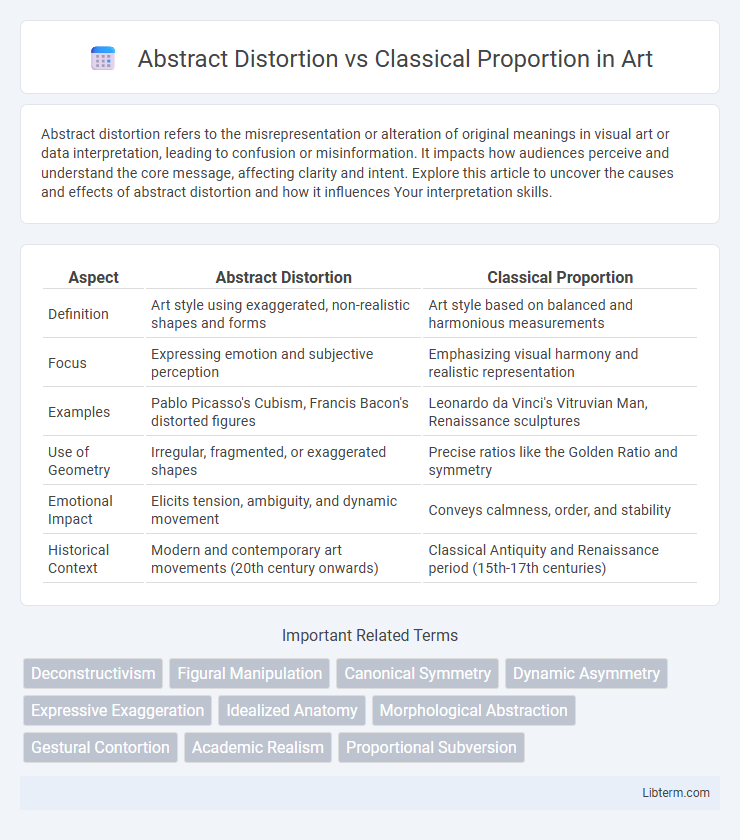Abstract distortion refers to the misrepresentation or alteration of original meanings in visual art or data interpretation, leading to confusion or misinformation. It impacts how audiences perceive and understand the core message, affecting clarity and intent. Explore this article to uncover the causes and effects of abstract distortion and how it influences Your interpretation skills.
Table of Comparison
| Aspect | Abstract Distortion | Classical Proportion |
|---|---|---|
| Definition | Art style using exaggerated, non-realistic shapes and forms | Art style based on balanced and harmonious measurements |
| Focus | Expressing emotion and subjective perception | Emphasizing visual harmony and realistic representation |
| Examples | Pablo Picasso's Cubism, Francis Bacon's distorted figures | Leonardo da Vinci's Vitruvian Man, Renaissance sculptures |
| Use of Geometry | Irregular, fragmented, or exaggerated shapes | Precise ratios like the Golden Ratio and symmetry |
| Emotional Impact | Elicits tension, ambiguity, and dynamic movement | Conveys calmness, order, and stability |
| Historical Context | Modern and contemporary art movements (20th century onwards) | Classical Antiquity and Renaissance period (15th-17th centuries) |
Understanding Abstract Distortion
Abstract distortion challenges classical proportion by manipulating shapes and forms beyond traditional balance and symmetry, emphasizing emotional expression over mathematical accuracy. Understanding abstract distortion involves recognizing how artists intentionally alter dimensions to convey movement, tension, or subjective perspectives, creating a dynamic visual experience. This approach prioritizes conceptual depth and aesthetic impact rather than adhering to established proportional rules.
Defining Classical Proportion
Classical proportion is defined by harmonious ratios and balanced measurements rooted in ancient Greek and Roman architecture, emphasizing symmetry and mathematical precision. It relies on principles such as the Golden Ratio and the Vitruvian Triad, which guide the optimal relationship between parts to form a cohesive whole. This contrasts with abstract distortion, which intentionally alters or disrupts these established ratios to evoke emotion or challenge traditional aesthetics.
Historical Context: From Realism to Abstraction
The transition from realism to abstraction in art reflects a historical shift from classical proportion's strict adherence to naturalistic representation toward abstract distortion's expressive freedom. During the Renaissance, artists like Leonardo da Vinci emphasized mathematical harmony and ideal human anatomy, grounding visual art in empirical observation. By the early 20th century, movements such as Cubism and Expressionism challenged these conventions, prioritizing emotional intensity and subjective interpretation over precise proportion.
Key Principles of Classical Proportion
Classical proportion is grounded in mathematical ratios such as the Golden Ratio and the Rule of Thirds, ensuring harmony and balance within artwork or architecture. These key principles prioritize symmetry, scale, and precise measurement to create aesthetically pleasing compositions that reflect order and natural beauty. Unlike abstract distortion, which intentionally breaks these conventions to evoke emotion or challenge perception, classical proportion maintains structural coherence and visual stability.
Techniques of Abstract Distortion
Techniques of abstract distortion involve intentional manipulation of shapes, colors, and spatial relationships to evoke emotion and challenge visual perception, contrasting sharply with the precise measurements and harmony found in classical proportion. Methods include exaggeration, fragmentation, and exaggeration of form, which disrupt traditional symmetry and balance to create dynamic, often surreal compositions. These techniques prioritize expressive freedom over mathematical accuracy, allowing artists to explore subjective experiences and conceptual depth beyond realistic representation.
Visual Impact and Audience Perception
Abstract distortion challenges classical proportion by bending traditional visual rules, creating dynamic and engaging compositions that evoke stronger emotional responses. The visual impact of abstract distortion often heightens audience perception by emphasizing form, color, and movement over realistic representation, leading to a more immersive experience. This shift from balanced symmetry to intentional imbalance directs viewer attention and encourages diverse interpretations.
Influential Artists and Art Movements
Abstract distortion emerged prominently through artists like Pablo Picasso and Georges Braque, who pioneered Cubism by breaking classical proportions to depict multiple perspectives simultaneously. The Surrealist movement, with Salvador Dali and Max Ernst, further challenged traditional proportions to explore subconscious realities and dreamlike forms. These artists and movements fundamentally shifted art toward emphasizing emotional expression and conceptual depth over classical balance and symmetry.
Applications in Contemporary Art
Abstract distortion in contemporary art challenges classical proportion by emphasizing emotional expression and subjective interpretation over mathematical harmony and realistic representation. This approach allows artists to explore dynamic compositions and evoke visceral responses, often breaking traditional rules of scale and symmetry to create innovative visual experiences. Applications in contemporary art include surrealism, cubism, and expressionism, where distorted forms serve to convey psychological depth and critique conventional aesthetics.
Balancing Distortion and Proportion
Balancing abstract distortion with classical proportion involves carefully manipulating shapes and forms to create dynamic compositions that maintain visual harmony. Abstract distortion challenges traditional ratios by emphasizing individuality and emotional expression, while classical proportion relies on established mathematical relationships for aesthetic stability. Achieving equilibrium requires integrating exaggerated elements without compromising the underlying structural coherence of the piece.
Future Trends in Artistic Representation
Abstract distortion challenges the classical proportion by emphasizing emotional expression over precise anatomical accuracy, promoting creative freedom in future artistic representation. Emerging trends suggest a fusion of digital technology and immersive media, enabling artists to manipulate proportions dynamically and explore abstract forms in interactive environments. This shift fosters innovative visual languages that resonate with contemporary audiences seeking non-traditional aesthetics and experiential depth.
Abstract Distortion Infographic

 libterm.com
libterm.com